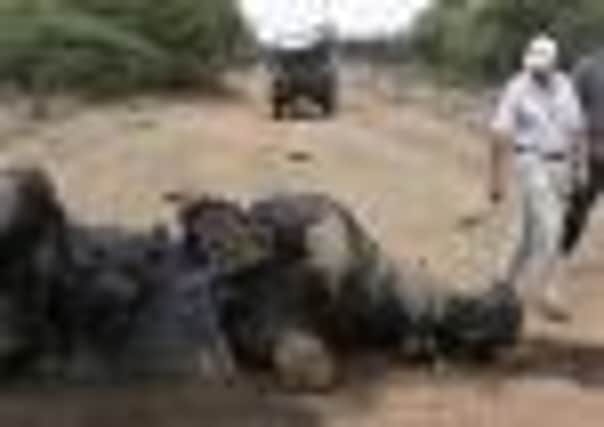South Africa: Poaching surge threatens rhinos


Hunters killed eight rhinos at the private Finfoot Game Reserve inside the Vaalkop Dam Nature Reserve this month with single rifle shots that pierced their hearts and lungs. The poachers took the rhinos’ horns and cut off the dead animals’ snouts for buyers in Asia.
The insatiable demand for horns has sparked the worst recorded year of rhino poaching in South Africa in decades, with at least 588 rhinos killed so far, their carcasses rotting in private farms and national parks. Without drastic change, experts warn that soon the number of rhinos killed will outpace the number of the calves born – putting the entire population at risk in a nation that is the last bastion for the prehistoric-looking animals.
Advertisement
Hide AdAdvertisement
Hide Ad“This is a full-on bush war we are fighting,” said Marc Lappeman, who runs the Finfoot reserve with his father, Miles. “We here are willing to die for these animals.” They have begun armed patrols to protect their remaining rhinos.
Unchecked hunting nearly killed off all the rhinos in southern Africa at the beginning of the 1900s. Conservationists in the 1960s airlifted rhinos to different parts of South Africa to spread them out. That helped the population grow to the point that the country is now home to about 20,000 rhinos – 90 per cent of all those in Africa.
From the 1990s to 2007, rhino poachings in South Africa averaged about 15 a year, according to a recent report by Traffic, which monitors the wildlife trade. But in 2008, poachers killed 83 rhinos and 122 in 2009.
The killings grew exponentially after that: 333 in 2010, 448 in 2011 and as of Tuesday this week, at least 588 this year, according to South Africa’s department of environmental affairs.
Government data shows that most of the killings are in South Africa’s massive Kruger National Park, which covers 7,500 square miles in the country’s north-east abutting the borders with Mozambique and Zimbabwe.
There, the impoverished slip across the park’s borders, largely from Mozambique, to kill and dehorn rhino, earning the equivalent of several months’ wages in a single night of hunting. The horns are sold by criminal gangs and smuggled into Asia. South Africa has deployed soldiers in the park with dogs to sniff out poachers, but their small force can’t effectively cover such a massive area.
While some poachers have been shot dead and hundreds of suspects arrested this year, the rhino killings continue unstopped largely because the trade is transnational and worth millions of dollars, said Julian Rademeyer, a journalist in South Africa who wrote Killing for Profit, a book on rhino poaching that came out this month.
Law enforcement can’t always be trusted: there have been several cases of rangers being arrested for aiding poachers. And while rhino hunting is legal in South Africa, criminal gangs have obtained hunting licences under false pretences.
Advertisement
Hide AdAdvertisement
Hide AdRhino horn is made of keratin, a tough protein also found in human fingernails. Doctors have repeatedly said the material has no medical value. In Asia, however, demand for rhino horn has jumped dramatically. Experts blame it partly on a widespread rumour in Vietnam that rhino horn cures cancer, though some use it as a hangover cure.